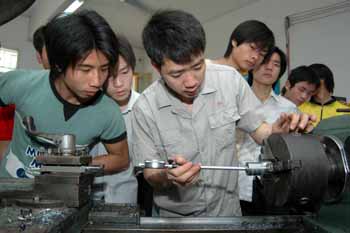| Tools: Save | Print | E-mail | Most Read |
| China Questions and Answers |
| Adjust font size: |
Q: Many say that the unemployment problem that China is facing is actually a global headache. Particularly, during its reform and opening up, China faces a dual employment pressure as enterprises cut staff and rural laborers move to cities for jobs. How will China manage this thorny problem? What will it do to keep the unemployment rate within a socially tolerable range? A: Employment has a vital bearing on people's livelihoods. It is the fundamental prerequisite and basic approach for people to improve their lives. As a country with a population of 1.3 billion, China is burdened with a heavy task. It is a universal practice to expand employment through economic development. However, since the 1990s, a 1-percentage-point increase in China's GDP has only been able to translate into an increase of 600,000-700,000 jobs. So, it's hard for China to solve the employment problem by solely relying on economic development. Therefore, the government has created a series of proactive employment policies and has established a principle of "workers finding their own jobs, employment through market regulation and employment promoted by the government." An employment mechanism with the market playing a leading role is coming into shape, and this has helped more to get employed. First, China has taken controlling unemployment rate and increasing job opportunities as one of its principal macro-control targets and incorporates it in the country's plan for economic and social development. Adhering to the policy of expanding domestic demand, China is making great efforts to adjust the economic structure so as to maintain a steady and fairly rapid development and enhance the motive power of economic growth in stimulating employment. Second, China has taken the development of the service industry as a major approach for the expansion of employment opportunities. It encourages the development of community services, catering, commerce, trade and tourism for the purpose of creating more job opportunities in these sectors. A considerable number of laid-off workers and people who have difficulties finding jobs have been successfully reemployed. Third, China encourages the development of labor-intensive industries and enterprises that have comparative advantages and whose products enjoy market demands—in particular, private and self-employed businesses and medium and small enterprises with big employment capacity. These industries, businesses and enterprises have accounted for about 80 percent of the new employment in urban areas each year. Fourth, China encourages people to get employed through various ways by developing labor outsourcing organizations and employment bases with a view to providing services and assistance for flexible employment. Moreover, the government has put in place a medical insurance policy for part-time employees and temporary workers and has set up systems for dealing with labor relations, wage payment, and social insurance, to promote and protect the legitimate rights and interests of those who obtained jobs in a flexible manner. Fifth, China actively fosters and develops the labor market and has gradually established the enterprises' status as the major employers and the laborers' status as the major labor suppliers. At the same time, it has taken measures to coordinate and promote reform in the social security system, the housing system and the household registration system. As a result, the environment for labor market development has been noticeably improved, and the market mechanism is now playing a fundamental role in the allocation of labor resources. Thanks to measures taken by the country to promote reemployment, strengthen control over unemployment and standardize staff cuts, in 2004, 9.8 million new urban laborers found jobs while 5.1 million laid-off workers in urban areas were reemployed, with a registered unemployment rate of 4.2 percent, a decrease of 0.1 percentage point compared with the previous year. The current challenge facing China is that the working-age population keeps increasing at an average annual rate of 13.6 million, plus 150 million surplus rural laborers needing to be transferred to sectors apart from agriculture and millions of unemployed and laid-off persons needing to be employed and reemployed. While there exists a conflict between the supply of and demand for labor, the problem of structural unemployment that results from a mismatch between laborers' quality and job requirements is becoming increasingly serious. As a result, the employment problem has become more complicated. China's general objective for solving the employment problem is as follows: In line with the requirements of building a moderately prosperous society in an all-around way, efforts should be made to increase job opportunities through developing the economy and improving its structure, and to enhance laborers' capability through strengthening education and training, so as to ensure relatively full development and rational use of China's abundant labor resources. At the same time, a better environment should be created for the laborers to choose jobs on their own move and start their businesses freely. An open, uniform, standardized and orderly labor market that encourages equal competition should be developed, and efforts should be made to keep the unemployment rate and the average unemployment cycle within a limit that society can sustain, and to offer equal job opportunities to all who have the ability and intention to work or are ready for employment.
|
| Tools: Save | Print | E-mail | Most Read |
 |
| Related Stories |
|
Product Directory China Search |
Country Search Hot Buys |
